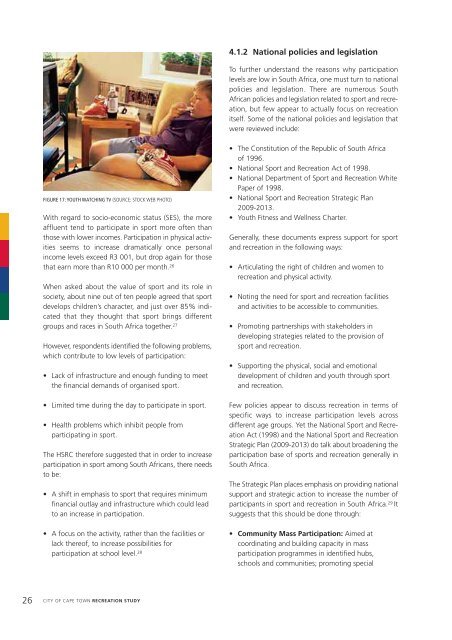Recreation Study
Recreation Study
Recreation Study
- No tags were found...
You also want an ePaper? Increase the reach of your titles
YUMPU automatically turns print PDFs into web optimized ePapers that Google loves.
4.1.2 National policies and legislationTo further understand the reasons why participationlevels are low in South Africa, one must turn to nationalpolicies and legislation. There are numerous SouthAfrican policies and legislation related to sport and recreation,but few appear to actually focus on recreationitself. Some of the national policies and legislation thatwere reviewed include:FIGURE 17: YOUTH WATCHING TV (SOURCE: STOCK WEB PHOTO)With regard to socio-economic status (SES), the moreaffluent tend to participate in sport more often thanthose with lower incomes. Participation in physical activitiesseems to increase dramatically once personalincome levels exceed R3 001, but drop again for thosethat earn more than R10 000 per month. 26When asked about the value of sport and its role insociety, about nine out of ten people agreed that sportdevelops children’s character, and just over 85% indicatedthat they thought that sport brings differentgroups and races in South Africa together. 27However, respondents identified the following problems,which contribute to low levels of participation:• Lack of infrastructure and enough funding to meetthe financial demands of organised sport.• Limited time during the day to participate in sport.• Health problems which inhibit people fromparticipating in sport.The HSRC therefore suggested that in order to increaseparticipation in sport among South Africans, there needsto be:• A shift in emphasis to sport that requires minimumfinancial outlay and infrastructure which could leadto an increase in participation.• A focus on the activity, rather than the facilities orlack thereof, to increase possibilities forparticipation at school level. 28• The Constitution of the Republic of South Africaof 1996.• National Sport and <strong>Recreation</strong> Act of 1998.• National Department of Sport and <strong>Recreation</strong> WhitePaper of 1998.• National Sport and <strong>Recreation</strong> Strategic Plan2009-2013.• Youth Fitness and Wellness Charter.Generally, these documents express support for sportand recreation in the following ways:• Articulating the right of children and women torecreation and physical activity.• Noting the need for sport and recreation facilitiesand activities to be accessible to communities.• Promoting partnerships with stakeholders indeveloping strategies related to the provision ofsport and recreation.• Supporting the physical, social and emotionaldevelopment of children and youth through sportand recreation.Few policies appear to discuss recreation in terms ofspecific ways to increase participation levels acrossdifferent age groups. Yet the National Sport and <strong>Recreation</strong>Act (1998) and the National Sport and <strong>Recreation</strong>Strategic Plan (2009-2013) do talk about broadening theparticipation base of sports and recreation generally inSouth Africa.The Strategic Plan places emphasis on providing nationalsupport and strategic action to increase the number ofparticipants in sport and recreation in South Africa. 29 Itsuggests that this should be done through:• Community Mass Participation: Aimed atcoordinating and building capacity in massparticipation programmes in identified hubs,schools and communities; promoting special26 CITY OF CAPE TOWN RECREATION STUDY


